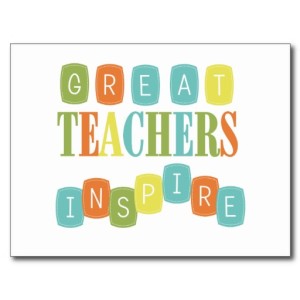In this month’s #InspirationalEducator Series, Jake Miller sat down with someone who isn’t necessarily an “educator” by trade. Ms. Valerie Hegarty is an artist who focuses in educational aspects, namely history, and her thoughtful, incredible, outside-the-box 3-D art caught the eye of this social studies teacher. He found more information about her online and decided to ask for an interview, which she agreed to. The excerpts of that interview are shared with you below:
 Jake Miller: Your art is quite an interesting blend of classical portraits, mosaics, and craftsman work with a modern, three-dimensional twist to them. How did you come to create this type of art?
Jake Miller: Your art is quite an interesting blend of classical portraits, mosaics, and craftsman work with a modern, three-dimensional twist to them. How did you come to create this type of art?
Valerie Hegarty: I’ve been making art since I was a kid, so it’s hard to describe exactly the path that brought me to the present work. However, in graduate school I was interested in recreating spaces from my present life by gluing layers of painted paper to the walls and floors of a gallery. The final layer of paper I would paint white so it matched the gallery walls. I then would scrape the paper off again which made it look like a very old space under the gallery walls. In this way I felt like an archeologist re-discovering a space from my own memory and history (to see an example of this work, click here)
At some point I was asked to make a piece for an art fair and I wasn’t allowed to mess up the walls, so I decided to make a painting that I then could alter in some way. I started copying paintings from American historical art, and the work moved from being about my personal history to more of a collective history.
JM: Which piece of yours has so far been your proudest? Why?
VH: One of my favorite pieces to date is “Watermelon Tongue” from 2012. It’s a painting of a slice of watermelon that looks like it’s turning into a three-dimensional tongue. I like that it’s a full transformation of a still life painting into a body part; the traditional still lifes often represented the passage of time and alluded to mortality and the body (i.e., a cheek is compared to an apple; a peach is compared to a breast). This piece also came about when I saw recent news articles about crops of watermelons in Mexico and China that were exploding because they were sprayed with the wrong growth hormones; their insides were growing faster than their outsides. I was playing with making the inside of the watermelon growing into three-dimensions, and by chance it started to look like a tongue, so I went with that. I also like that it looks like the watermelon is sticking its tongue out at the viewer, as if to say, “Ha Ha! See what happens when you mess with me?”
JM: What are you currently working on for your next showing?
VH: I just completed a new work called “Slo Mo Exploded Watermelon” for a group show in Brooklyn. The fruit looks like it’s captured mid explosion. This coming year I want to play and experiment without deadlines to create a new body of work without a timeline. I don’t know what the new work is going to look like, and that’s exciting.
JM: Describe what art classes were like for you growing up. Were any teachers impactful? How did they challenge you and how did you continue to challenge yourself?
VH: I took some art classes in school, but most impactful was that I seemed always be creating stuff at home. I love to draw, paint, sew, build dioramas in shoe boxes, make paper-mache masks and dolls, and create costumes—all from household materials. I do remember my first grade art teacher and how he taught us the symbolism in a Japanese painting of three flowers. I loved painting the three flowers at 3 different heights and thinking about how they stood for larger ideas of heaven, earth, and man (if I’m remembering correctly).
In middle school, I was in some sort of accelerated group where I could leave the class during certain times and go to the art room. I would go there as much as I could. I loved when teachers in other subjects incorporated art into the lesson plan. I remember having to draw posters for science experiments, and I’d always show up with 20 posters (where most students would have made 1). I found it embarrassing.
Then when I took an art class in college, I suddenly thought, “This is what people mean when they say they feel passionate about something.” I just loved it and decided to make it my major. That’s when I felt more challenged. Suddenly the work needed more thought beforehand, and I needed to talk about my ideas to the class. This is still how I challenge myself, doing artist talks at colleges and continually considering the conceptual framework for the pieces I want to make.
JM: When you decided to be an artist, did you find more encouragement or discouragement from my teachers, friends, and family?
VH: When I was younger, I received encouragement from teachers because I was shy and didn’t talk much, and I liked to make pictures. I didn’t get much encouragement in general when I switched my major to art in college. My parents were worried I wouldn’t find a job out of school; I wasn’t really a standout art student in college, and it was new and confusing to me. The bigger question revolved around what I was doing and what I would do after college. It wasn’t until graduate school where I felt very encouraged by my teachers and my peers, mainly because I worked really hard and was inventive. My parents became supportive later on when they saw that I was really sticking to what I wanted to do, even though it was hard, they respected me for doing what I loved and not giving up. My friends and family now are my biggest supporters.
JM: Is it difficult to make ends meet as an artist, as most Americans generally stereotype?
VH: Yes it is. I do sell my work but the pieces take a lot of time and energy to make. And there are all the additional costs such as art studio rent, supplies, and documentation of the work. Sometimes I teach for extra money or work part-time jobs. It’s always up and down without having a 9-5 job. I also live in New York City, and that has very high rent and a high cost of living. I’m hoping to transition into a college teaching job eventually; that way I can create my work and also be involved with exchanging ideas with students on a regular basis.
JM: You’re our first “non-traditional teacher” to be featured in this series, yet I find there is a huge component of education in your art – especially in history and art history. Would you agree?
VH: I agree, my work is often used for educational purposes at places like The Brooklyn Museum. Here they have one of my decayed American landscape paintings hanging in the American Wing. The work can refer to elements of American history, American art history, and environmental studies. Those types of landscape paintings were important in defining an American identity that was separate from Europe—the American paintings showing the untamed and unlimited resources of the West. And Manifest Destiny was shown as implicit in these paintings with the heavenly light source sweeping westward. So to copy and degrade one of these paintings could cause problematic implications of Manifest Destiny, the American identity, and the erosion of the wilderness through industrialization.
In terms of teaching, I taught an installation class last year at the Rhode Island School of Art and Design and have worked with the Brooklyn Museum and Rush Arts to teach local kids and teens. I also visit many art colleges across the United States to give talks and meet with students. So while I’m not your traditional teacher, I do feel I’m strongly involved in education.
JM: That being said, is it me, or do you seem to have an affinity for George Washington? (Laughs) Care to explain?
VH: When I first made a melted portrait of George Washington, I wanted to pick an iconic portrait of American identity from history, and his portrait I think is the most recognizable. Likewise, he being the father of our country adds a level of meaning. I often repeat subject matter to explore ideas, and I think he is the only portrait I have used.
JM: Who is / are your favorite artist(s)? Why?
VH: I always have a hard time answering this question. I don’t have a lot of favorites; I like far too many and I feel like even the ones I don’t like might be influential in some way. That being said, I can list a few: Duchamp (for his concepts and humor), Gordon Matta Clark (for his creating with deconstruction), and Magritte (for his magic realism). I could list 100’s of artists, so I’m just going to list 3. I also like Magic Realist writers like Octavio Paz, Jose Saramago, as well as gothic writers like Oscar Wilde and Edgar Allen Poe.
JM: What concerns you about the future of art education in our schools?
VH: I’m concerned that some people don’t understand the necessity of art education in schools. It seems to be the first thing to get cut from school budgets. I believe art teaches students invaluable skills such as innovative thinking, conceptualizing and verbalizing ideas, visualizing ideas, creative self-expression – to name a few. All these skills are necessary in any other field of study. I also think art is invaluable for students as a path to self-discovery and a means to process life experiences.
JM: Do you have any suggestions for teachers of core subjects (elementary, math, science, reading, social studies, English, languages, etc.) about how to better incorporate art into their discipline?
VH: I’ve worked with The Brooklyn Museum, conducting workshops to help school teachers incorporate art into their lesson plans. Each subject would approach it a bit differently, but, for example, social studies/history teachers could printout images of early American landscape paintings with their pristine vistas and wilderness and have them imagine how it looks today. Have them alter the images using a collage (having a pile of magazines, scissors and glue sticks). Have them talk about and list the positive impacts of industrial development and also the negative impacts on the landscape. What steps could be taken to increase the positive? Decrease the negative? Etc. I think the more teachers of core subjects can work with a teaching artist to come up with a curriculum idea, the more they could engage the students in a different way. (For examples on Ms. Hegarty’s suggestions online, click here for downloadable packets from the Brooklyn Museum)
JM: Thank you for your time, Ms. Hegarty, and thank you for sharing your artistic gifts and talents with the educational world.
VH: Thank you for your time also and being interested in the work!



